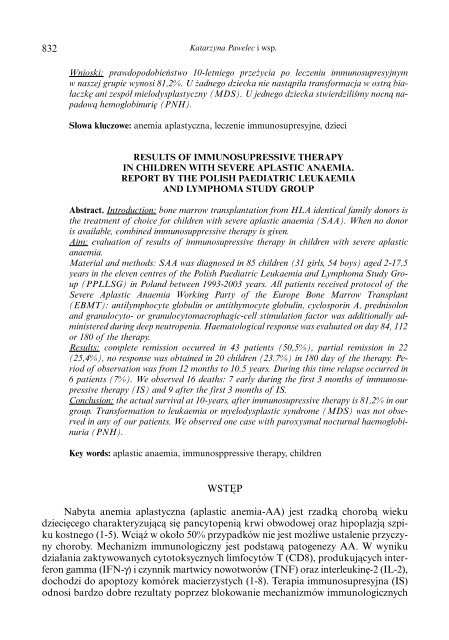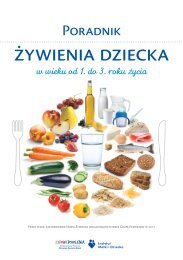Medycyna Wieku Rozwojowego
Medycyna Wieku Rozwojowego
Medycyna Wieku Rozwojowego
You also want an ePaper? Increase the reach of your titles
YUMPU automatically turns print PDFs into web optimized ePapers that Google loves.
832<br />
Katarzyna Pawelec i wsp.<br />
Wnioski: prawdopodobieƒstwo 10-letniego prze˝ycia po leczeniu immunosupresyjnym<br />
w naszej grupie wynosi 81,2%. U ˝adnego dziecka nie nastàpi∏a transformacja w ostrà bia-<br />
∏aczk´ ani zespó∏ mielodysplastyczny (MDS). U jednego dziecka stwierdziliÊmy nocnà napadowà<br />
hemoglobinuri´ (PNH).<br />
S∏owa kluczowe: anemia aplastyczna, leczenie immunosupresyjne, dzieci<br />
RESULTS OF IMMUNOSUPRESSIVE THERAPY<br />
IN CHILDREN WITH SEVERE APLASTIC ANAEMIA.<br />
REPORT BY THE POLISH PAEDIATRIC LEUKAEMIA<br />
AND LYMPHOMA STUDY GROUP<br />
Abstract. Introduction: bone marrow transplantation from HLA identical family donors is<br />
the treatment of choice for children with severe aplastic anaemia (SAA). When no donor<br />
is available, combined immunosuppressive therapy is given.<br />
Aim: evaluation of results of immunosupressive therapy in children with severe aplastic<br />
anaemia.<br />
Material and methods: SAA was diagnosed in 85 children (31 girls, 54 boys) aged 2-17,5<br />
years in the eleven centres of the Polish Paediatric Leukaemia and Lymphoma Study Group<br />
(PPLLSG) in Poland between 1993-2003 years. All patients received protocol of the<br />
Severe Aplastic Anaemia Working Party of the Europe Bone Marrow Transplant<br />
(EBMT): antilymphocyte globulin or antithymocyte globulin, cyclosporin A, prednisolon<br />
and granulocyto- or granulocytomacrophagic-cell stimulation factor was additionally administered<br />
during deep neutropenia. Haematological response was evaluated on day 84, 112<br />
or 180 of the therapy.<br />
Results: complete remission occurred in 43 patients (50,5%), partial remission in 22<br />
(25,4%), no response was obtained in 20 children (23.7%) in 180 day of the therapy. Period<br />
of observation was from 12 months to 10.5 years. During this time relapse occurred in<br />
6 patients (7%). We observed 16 deaths: 7 early during the first 3 months of immunosupressive<br />
therapy (IS) and 9 after the first 3 months of IS.<br />
Conclusion: the actual survival at 10-years, after immunosupressive therapy is 81,2% in our<br />
group. Transformation to leukaemia or myelodysplastic syndrome (MDS) was not observed<br />
in any of our patients. We observed one case with paroxysmal nocturnal haemoglobinuria<br />
(PNH).<br />
Key words: aplastic anaemia, immunosppressive therapy, children<br />
WST¢P<br />
Nabyta anemia aplastyczna (aplastic anemia-AA) jest rzadkà chorobà wieku<br />
dzieci´cego charakteryzujàcà si´ pancytopenià krwi obwodowej oraz hipoplazjà szpiku<br />
kostnego (1-5). Wcià˝ w oko∏o 50% przypadków nie jest mo˝liwe ustalenie przyczyny<br />
choroby. Mechanizm immunologiczny jest podstawà patogenezy AA. W wyniku<br />
dzia∏ania zaktywowanych cytotoksycznych limfocytów T (CD8), produkujàcych interferon<br />
gamma (IFN-γ) i czynnik martwicy nowotworów (TNF) oraz interleukin´-2 (IL-2),<br />
dochodzi do apoptozy komórek macierzystych (1-8). Terapia immunosupresyjna (IS)<br />
odnosi bardzo dobre rezultaty poprzez blokowanie mechanizmów immunologicznych



